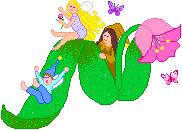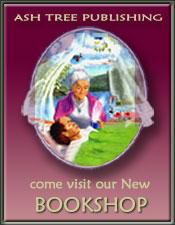The Wise Woman Tradition - Herbal Wisdom
The Wise Woman Tradition
Susun Weed’s Wisdom
For NLJ, Corinna Wood interviews renowned herbalist Susun Weed about the Wise Woman Tradition and the importance of herbal medicine—for both men and women—in today’s world.
Susun Weed is a teacher with an encyclopedic knowledge of herbs and health. She is the voice of the Wise Woman Way—where common “weeds,” simple ceremony, and compassionate listening support and nourish health—and the author of four books on herbal medicine. She will be in the Asheville area this October teaching at the Southeast Women’s Herbal Conference.

NLJ: Please describe the Wise Woman Tradition in your own words.
SW: The Wise Woman Tradition nourishes wholeness and honors female ways of knowing. All women and all men need to love and honor their female selves. The Wise Woman Tradition invites everyone to weave themselves into greater wholeness. 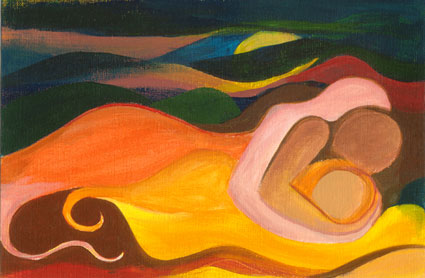 By contrast, the heroic tradition, or alternative medicine, believes that toxins cause disease and must be vigorously removed with colon cleansing and “detoxifying” treatments.
By contrast, the heroic tradition, or alternative medicine, believes that toxins cause disease and must be vigorously removed with colon cleansing and “detoxifying” treatments.
All Traditions—the Scientific, the Heroic, and the Wise Woman—agree that the health of the individual is only as good as the health of their intestines. The Heroic Tradition focuses on cleansing parasites and “sludge” from the intestines. The Wise Woman Tradition reminds us that we are not meant to live alone. Bacteria and other microorganisms can cause disease, but they are also the foundation of health. There are more beneficial bacteria in a healthy person’s intestines than there are cells in that person’s body. Preservatives in processed foods kill these beneficial bacteria. So do anti-bacterial soaps, chlorine in the water (even if you don’t drink it), antibiotics, and essential oils (even inhaled). To nourish gut flora, we need fermented foods like yogurt, miso, sauerkraut, and beer; we need mushrooms and yeasts and moldy cheeses like brie and blue and camembert.
The Wise Woman Tradition says we are already perfect and whole. The goal is neither to eliminate disease or prevent death, but simply to nourish the wholeness of each unique individual, so that when they die, as we all must, they die wholene, rather than in parts.
NLJ: How can New Life Journal readers incorporate the Wise Woman Tradition into their lives?
SW: Start by drinking nourishing herbal infusions. These powerhouses of nourishment help us regain and maintain optimum health. I am fiercely anti-supplement, but I do understand how difficult it can be to get adequate nutrition, especially the minerals we need, from our meals. Nourishing herbal infusions provide lavish amounts of minerals, as well as huge amounts of vitamins. They are rich in proteins and other important phytonutrients, such polyphenols and phytoestrogens, too. The minerals in nourishing herbal infusions are immediately available to our bodies because they have the opposite charge of the blood. Thus, they are magnetically attracted into the blood stream and bypass digestion altogether. The effects are immediate and obvious. Most people notice improvements in energy, skin, and general well being within a week of drinking at least two cups of nourishing herbal infusion a day.
A nourishing herbal infusion uses a large amount of dried herb, and steeps it for a long time in order to extract the nutrients. [See sidebar for infusion how-to.] An herbal tea, a small amount of fresh or dried herb is steeped for a short time, cannot compare in nutritional value.
A capsule of powdered nettle provides no calcium. A dropperful of nettle tincture provides 1-5 mg of calcium. A cup of nettle tea has about 20 mg of calcium. A cup of nettle infusion contains between 200-250 mg of calcium. And remember, women who take calcium supplements are twice as likely to break a bone as women who get their calcium from foods, even if those women consume only 800 mg of calcium a day.
Drinking nourishing herbal infusions is also a great way to save money too! The average American spends $100 monthly on supplements; the average health-conscious American spends more than $250 a month on supplements (1). A quart of nourishing herbal infusion provides more minerals and more vitamins than any supplement, and it costs less than $25 per month if you buy your herb in bulk, wholesale. (A reasonable thing to do, as you will be using two pounds of herb per month, or 25 pounds a year, if you drink a quart a day.)
NLJ: Sales are generally decreasing in this slow economy, yet I’ve heard stores report that they’re seeing an increase in herb sales. People probably also want to learn more about how to make their own medicines straight from the earth. Do you agree?
SW: Yes. You may lose your job and your health insurance, but the medicines of the earth will never abandon you. Green blessings are always waiting for us to recognize them and utilize them. Look at my course offerings, and you’ll see an interesting change over the past five years. I used to offer one class a year called “Hands-On Herbal Medicine,” where we made infusions, tinctures, vinegars, ointments, and herbal honeys.  Now, almost a third of my classes are Hands-On classes. I see how much confidence my students gain when we go out together to identify, pick, prepare and use the plants that grow around them. We make salads and soups; we dry herbs; we get our hands on the plants and listen to them.
Now, almost a third of my classes are Hands-On classes. I see how much confidence my students gain when we go out together to identify, pick, prepare and use the plants that grow around them. We make salads and soups; we dry herbs; we get our hands on the plants and listen to them.
Herbal medicine is people’s medicine. It always has been, and always will be. The World Health Organization says that 90 percent of all heath care is done by women in their own homes using simple herbal remedies (2). Many modern westernized cultures rely on drugs and are suspicious of herbal medicines. While drugs and surgery can be miraculous, I don’t think anyone would disagree that they are overused.
It bothers me when people said that I do “alternative” medicine. Herbs are not alternative; they are traditional. Herbal medicine is traditional medicine. Simple herbal remedies are safe and effective primary medicines and excellent complementary medicines when we must choose drugs or surgery.
NLJ: Although there is growing acceptance, the medical community is still wary of herbal medicines. How safe are herbs?
SW: How safe is a car? As safe as the person operating it! Herbs are not inherently safe or unsafe. By conservative estimate, there are more than 10,000 plants used worldwide as herbal medicines. How could one say they are safe or dangerous? Most plants, even food plants, contain poisons. Preparation and dosage determine safety, and this is as true of a drug as it is of an herb.
That said, any herb powdered and put into a capsule is dangerous (unless it is useless). Consider the herb ephedra. Chinese herbalists have used Ma Huang (ephedra) without ill effect for over 3,000 years. The Mormons made use of ephedra as a tea, again without harm. But powdered, encapsulated, and taken in high doses by women intent on losing weight, ephedra has caused so many fatalities that it has been banned in the U.S.A. What an ignoble end to a helpful herb! I never take herbs in capsules, and I warn my students against doing so.
Here’s another way to look at the relative safety of herbs: divide them into broad categories. In each of my books, I divide the herbs I discuss in that book into four groups: nourishing, tonifying, stimulating/sedating, and potentially poisonous.
- Nourishing herbs. Food-like herbs, such as nettle, dandelion, chickweed, red clover, oatstraw, and burdock, are beneficial in any dose, no matter how large, and are safe to use with other herbs and drugs.
- Tonifying herbs. Herbs that build or slowly alter health, such as motherwort, astragalus, echinacea, linden, and yellow dock, need to be more carefully dosed than nourishing herbs, but are still safe in nearly any quantity. They interface easily with other herbs and drugs.
- Stimulating/Sedating herbs. Plants that have enough strong to act in drug-like ways in the body, such as valerian, yarrow, and black cohosh are safe when used in the smallest effective dose for the shortest possible time. Their interactions with drugs are as well understood as the interactions between various drugs.
- Potentially poisonous herbs. These are the “big guns” of the herbal world. This is where the herbalist leans toward pharmacy, and tinctures become standardized. Goldenseal, poke root, cayenne, opium poppy and quinine are a few examples. For safety’s sake, it is best not to mix these plants with drugs. But I’ve never heard a doctor tell a patient to avoid cayenne when writing a drug prescription, so even here I am not very concerned about detrimental interactions.
The safety of herbs is relative. Parsley can cause abortion or kidney damage (when inserted vaginally or consumed as a juice). But no one stops eating parsley because they are taking a drug. Since most of the population of the U.S.A. takes drugs daily—whether to lower cholesterol or blood pressure or for other reasons—creating uncertainty about herb/drug interactions is a good way to scare most people away from using herbs.
The proper dose, given as needed, of any herb, no matter how strong—so long as it’s not in a capsule—is unlikely to cause permanent harm. Understand that 100,000 people per year in the U.S. die from properly prescribed drugs, properly taken (3). Modern medicine’s fear of herbs is mistaken, and basically a chimera, a fantasy with no basis in reality.
NLJ: Your message of using local “weeds” as medicine applies to both men and women. Why do you focus on women’s health, especially in your writing?
SW: My classes are filled with women. More women than men seek help with their health. Women have more physical changes than men—menstruation, pregnancy, childbirth, lactation, menopause— more times where professionals can “help.” It breaks my heart to see so many women’s lives and health damaged and disturbed by modern medicine and its disempowering stories. I am moved to speak out, and to write, hoping to offer help and hope and new stories where women are honored in their changing bodies.
NLJ: What’s a current health issue about which you’re you especially passionate?
SW: There are several. I am incensed at the damage done by cancer screening. Mammograms, Pap smears, PSA tests, and colonoscopies do not decrease mortality and often damage health for no reason other than fear. This is one of the topics in my newest book Down There the Wise Woman Way, Sexual and Reproductive Health for Women and All the Men They Love (available in 2010 from Ash Tree Publishing). There are lots of ways to keep the cervix and prostate healthy and avoid the damage of screening tests.
And, I get upset whenever a woman tells me she is taking a statin drug. These drugs do lower her cholesterol, but they don’t reduce mortality(4). It is just a numbers game. No study has ever found a benefit for any woman from lowering her cholesterol by taking a statin. (5) In fact, high cholesterol in older women increases life span. In the future we will look back at the widespread use of statin drugs and shake our heads with dismay, much as we do now when we look back at the widespread prescribing of DES and thalidomide during pregnancy. I would rather see women using motherwort or hawthorn berry tincture to keep her heart and blood vessels healthy. These are green blessings. They keep us healthy and they keep the planet healthy!
For more information about Susun Weed and her workshops, apprenticeships and correspondence courses, visit www.susunweed.com. For more information about the Southeastern Women’s Herbal Conference October 2-4 in Black Mountain, NC visit www.sewisewomen.com or call 877-739-6636. Early bird discounts offered until May 15.
Sources: (1) www.vitaminretailer.com (2) www.who.int (3) JAMA, Lazarou J, Pomeranz B, Corey P. “Incidence of adverse drug reactions in hospitalized patients,” 1998 (4) www.medicalconsumers.org (5) www.theheart.org/article/915957.do
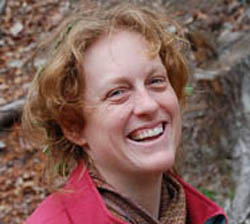 Corinna Wood is the director of Red Moon Herbs, an herbal medicine business focused on making medicines from fresh, abundant, local plants. Her background includes an extensive apprenticeship with Susun Weed in 1993; she founded the Southeast Women’s Herbal Conference and is on the faculty of the Appalachia School of Holistic Herbalism. Corinna lives and works at Earthaven Ecovillage, an intentional community in Black Mountain, NC. To learn about the Conference, Red Moon Herbs or Corinna’s Wise Woman Immersion courses, visit www.sewisewomen.com.
Corinna Wood is the director of Red Moon Herbs, an herbal medicine business focused on making medicines from fresh, abundant, local plants. Her background includes an extensive apprenticeship with Susun Weed in 1993; she founded the Southeast Women’s Herbal Conference and is on the faculty of the Appalachia School of Holistic Herbalism. Corinna lives and works at Earthaven Ecovillage, an intentional community in Black Mountain, NC. To learn about the Conference, Red Moon Herbs or Corinna’s Wise Woman Immersion courses, visit www.sewisewomen.com.

Susun’s Favorite Infusion Herbs
Stinging nettle (Urtica dioica): The energy of the earth. Wake up full of energy, work hard all day, and go to sleep easily. Builds energy form the inside out by nourishing the adrenals and kidneys. Restores health to the blood vessels, makes skin and hair beautiful.
Oatstraw (Avena sativa): The herb of longevity in Ayurverdic medicine. Known to maximize heart and blood vessel health. Great sexual tonic too!
Red clover (Trifolium pretense): Primarily grown as fodder for pregnant and lactating cows. The best fertility tonic,, the world’s most definitive anti-cancer herb, and a strengthener for the respiratory system.
Linden flowers (Tillia species): A powerful anti-inflammatory gentle enough to treat childhood colds. Reduces C-reactive protein (a predictor of heart attack susceptibility), eases joint pain, improves breathing.
Comfrey leaf (Symphytum uplandica): Heals and builds flexible strength in bones, muscles, ligaments, tendons, guts, lungs, and brain. The best memory tonic.
How-To Make A Nourishing Herbal Infusion
Place one ounce dry weight of herb (about two cups) in a quart canning jar. (Use half as much linden.) Fill jar to the top with boiling water and cap tightly. Steep for at least for four hours, overnight is fine. Strain the liquid out, squeezing the herb to get all the good from it. Stored in the refrigerator, it will last for several days. Drink your infusion hot or cold, with honey, miso, milk, fruit juice, whiskey, even instant coffee added for taste. A quart a day is excellent, but any is better than none!

Hands On Herbal Medicine 2 DVD set
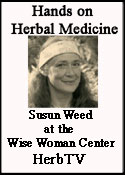 Hands On Herbal Medicine
Hands On Herbal Medicine
First Susun Weed leads her students on a walk around her land at the Wise Woman Center. She teaches about plant and animal cells, nourishing herbal infusions, digestive fire and grounding. Herbs discussed include mitchella, hemlock, sheep sorrel, white pine, nettles, and mushroom turkey tail. In the second part, Susun teaches about preparing herbs for use. The five menstruums she uses are honey, water, vodka, oil, and vinegar. Each one is explained and demonstrated. Herbs discussed include catnip, ginko, shiso, nettle, and wormwood.
Time: Part 1 - 1 hr 22 min Part 2 - 1 hr 28 min.
Produced in 2009 by HerbTV Studio
Price: $35.00
Order Hands On Herbal Medicine DVD in our Bookshop

 By contrast, the heroic tradition, or alternative medicine, believes that toxins cause disease and must be vigorously removed with colon cleansing and “detoxifying” treatments.
By contrast, the heroic tradition, or alternative medicine, believes that toxins cause disease and must be vigorously removed with colon cleansing and “detoxifying” treatments.  Now, almost a third of my classes are Hands-On classes. I see how much confidence my students gain when we go out together to identify, pick, prepare and use the plants that grow around them. We make salads and soups; we dry herbs; we get our hands on the plants and listen to them.
Now, almost a third of my classes are Hands-On classes. I see how much confidence my students gain when we go out together to identify, pick, prepare and use the plants that grow around them. We make salads and soups; we dry herbs; we get our hands on the plants and listen to them. Corinna Wood is the director of
Corinna Wood is the director of 
